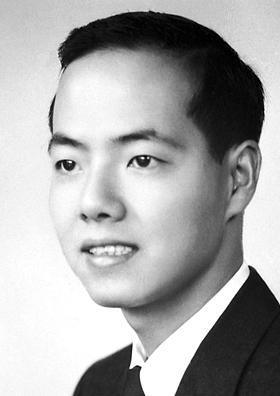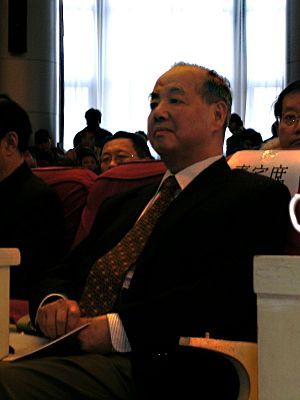Tsung-Dao Lee facts for kids
Quick facts for kids
Tsung-Dao Lee
|
|||||||||||||
|---|---|---|---|---|---|---|---|---|---|---|---|---|---|
| 李政道 | |||||||||||||

T. D. Lee in 1956
|
|||||||||||||
| Born | November 24, 1926 |
||||||||||||
| Died | August 4, 2024 (aged 97) |
||||||||||||
| Alma mater |
National Che Kiang University
|
||||||||||||
| Known for |
Lee–Yang theory
|
||||||||||||
| Awards |
Nobel Prize in Physics (1957)
|
||||||||||||
| Scientific career | |||||||||||||
| Fields | Physics | ||||||||||||
| Institutions | |||||||||||||
| Thesis | Hydrogen Content and Energy-productive Mechanism of White Dwarfs (1950) | ||||||||||||
| Doctoral advisor | Enrico Fermi | ||||||||||||
| Doctoral students |
Richard M. Friedberg
|
||||||||||||
| Chinese name | |||||||||||||
| Chinese | 李政道 | ||||||||||||
|
|||||||||||||
| Signature | |||||||||||||
 |
|||||||||||||
Tsung-Dao Lee (Chinese: 李政道; pinyin: Lǐ Zhèngdào; 24 November 1926 – 4 August 2024) was a brilliant Chinese-American physicist. He is famous for his important work on something called parity violation. This is a rule in physics that he and his colleague, Chen Ning Yang, showed could be broken in certain situations.
In 1957, when he was only 30 years old, Tsung-Dao Lee won the Nobel Prize in Physics. He shared it with Chen Ning Yang for their discovery about parity violation in weak interactions. Another scientist, Chien-Shiung Wu, proved their idea with a famous experiment.
Lee was the youngest person to win a Nobel Prize in science after World War II. He was also one of the youngest Nobel winners in science ever. Lee and Yang were the first Chinese people to receive a Nobel Prize. After becoming an American citizen in 1962, Lee also became the youngest American to win this prestigious award. He taught at Columbia University in New York City from 1953 until he retired in 2012.
Contents
About Tsung-Dao Lee
His Family Background
Tsung-Dao Lee was born in Shanghai, China. His family's ancestral home was in nearby Suzhou. His father, Chun-kang Lee, was a chemical industrialist and merchant. He helped develop modern fertilizers in China. Lee's grandfather, Chong-tan Lee, was the first Chinese senior pastor of St. John's Church in Suzhou.
Tsung-Dao Lee had four brothers and one sister. His brother, Robert C.T. Lee, also became an educator.
His Early Education
Lee went to high school in Shanghai and Jiangxi, China. His studies were interrupted by the Second Sino-Japanese war. Even though he didn't get a high school diploma, he was so talented that he was accepted directly into the National Che Kiang University in 1943.
He first studied chemical engineering, but his interest in physics quickly grew. Professors like Shu Xingbei and Wang Ganchang guided him. He soon switched to physics at National Che Kiang University. In 1945, due to more Japanese invasions, he continued his studies at the National Southwestern Associated University in Kunming. There, he learned from Professor Wu Ta-You.
Research in the United States
Professor Wu helped Lee get a fellowship to study in the United States. In 1946, Lee went to the University of Chicago. There, the famous physicist Enrico Fermi chose him as a PhD student. Lee earned his PhD in 1950 for his research on Hydrogen Content of White Dwarf Stars. After that, he worked at the University of California at Berkeley for a year.
In 1953, Lee joined Columbia University, where he stayed for the rest of his career. He started by working on a quantum field theory model. Soon, he became very interested in particle physics and a puzzle about how K meson particles decayed.
In 1956, Lee realized that the answer to this puzzle was parity non-conservation. This means that in certain physics processes, the universe doesn't behave the same way if you flip it like a mirror image. Lee suggested experiments to test this idea.
After Chien-Shiung Wu and her team proved that parity was indeed not conserved, Lee and Yang received the 1957 Nobel Prize in Physics. Many people believe that Wu should have also received the Nobel Prize for her crucial experimental proof.
In the 1960s, Lee and his colleagues started the field of high-energy neutrino physics. Later, in 1964, Lee and M. Nauenberg developed the KLN theorem. This theorem helps physicists deal with problems involving particles that have no mass, like gluons in quantum chromodynamics (QCD).
From 1974 to 1975, Lee wrote papers about a "New Form of Matter in High Density." This work led to the modern field of RHIC physics, which studies what happens when atomic nuclei collide at very high speeds.
Besides particle physics, Lee also worked on many other areas of physics. These included statistical mechanics, astrophysics, and the study of many-body systems. In 1983, he explored the idea of time being a discrete variable, leading to new ways of thinking about fundamental physics. Starting in 1975, Lee also helped create the field of non-topological solitons, which led to his work on soliton stars and black holes.
From 1997 to 2003, Lee directed the RIKEN-BNL Research Center. There, he and other researchers built powerful supercomputers for physics calculations. More recently, Lee and Richard M. Friedberg developed a new way to solve the Schrödinger equation, which is a key equation in quantum mechanics.
Helping Education
After China and the United States re-established relations, Lee and his wife, Jeannette Hui-Chun Chin, visited China. Lee gave lectures and helped organize the CUSPEA program. This program helped Chinese physics students apply to graduate schools in the U.S.
In 1998, Lee created the Chun-Tsung Endowment in memory of his wife. This fund gives scholarships to college students in China. These students are called "Chun-Tsung Scholars." The scholarships are given at six universities, including Shanghai Jiaotong University and Peking University.
Personal Life
Tsung-Dao Lee and Jeannette Hui-Chun Chin were married in 1950. They had two sons, James Lee and Stephen Lee.
Tsung-Dao Lee passed away in San Francisco on August 4, 2024, at the age of 97.
Awards and Honors
- Nobel Prize in Physics (1957)
- G. Bude Medal, Collège de France (1969, 1977)
- Galileo Galilei Medal (1979)
- Order of Merit, Grande Ufficiale, Italy (1986)
- Oskar Klein Memorial Lecture and Medal (1993)
- Science for Peace Prize (1994)
- China National-International Cooperation Award (1995)
- Matteucci Medal (1995)
- Small Planet 3443 named 3443 Leetsungdao (1997)
- New York City Science Award (1997)
- Pope Joannes Paulus Medal (1999)
- Ministero dell'Interno Medal of the Government of Italy (1999)
- New York Academy of Science Award (2000)
- The Order of the Rising Sun, Gold and Silver Star, Japan (2007)
- Marcel Grossmann Awards (2015)
Lee was also a member of many important scientific groups, including:
- National Academy of Sciences
- American Academy of Arts and Sciences
- American Philosophical Society
- Academia Sinica
- Accademia Nazionale dei Lincei
- Chinese Academy of Sciences
- Third World Academy of Sciences
- Pontifical Academy of Sciences
See also
 In Spanish: Tsung-Dao Lee para niños
In Spanish: Tsung-Dao Lee para niños
- Zhejiang Institute of Modern Physics
- Chinese people in New York City



